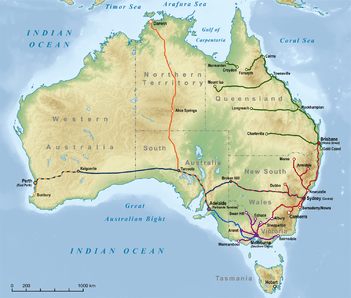Rail transport in Queensland
The rail network in Queensland, Australia, was the first in the world to adopt 1,067 mm (3 ft 6 in) narrow gauge for a main line, and now the second largest narrow gauge network in the world, consists of:
- the North Coast Line (NCL) extending 1,680 kilometres (1,040 mi) from Brisbane to Rockhampton, Townsville & Cairns
- Four east–west lines (and associated branch lines) connecting to the NCL:
- the Western line (including the Main Line) from Brisbane to Toowoomba & Charleville
- the Central Western line from Rockhampton to Longreach & Winton
- the Great Northern Railway from Townsville to Mount Isa
- the Tablelands line from Cairns to Atherton & Forsayth
- Four export coal networks:
- Moura to Gladstone
- Blackwater to Gladstone utilising the Central Western and NCL lines
- Goonyella to Hay Point
- Newlands to Abbot Point
- the original narrow gauge Southern line that provided a rail connection to Sydney, extending from Toowoomba to the New South Wales border at Wallangarra, plus the South Western line west from Warwick to Thallon;
- Two lines extending south of Brisbane, a 140 km/h (87 mph) narrow gauge passenger line from Brisbane to the Gold Coast, and a 1,435 mm (4 ft 8 1⁄2 in) line to the New South Wales border connecting to the line to Sydney
- the isolated Normanton to Croydon line, now operated as a tourist service as The Gulflander
- An isolated 19 kilometres (12 mi) 4 ft 8 1⁄2 in (1,435 mm) private freight line at Weipa hauling bauxite from a mine to the export terminal; and
- Over 3,000 km of 2 ft (610 mm) gauge sugar cane lines servicing 19 sugar mills (see Tramways section below).
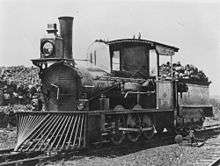
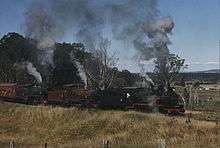
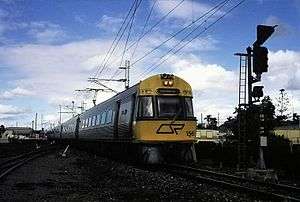
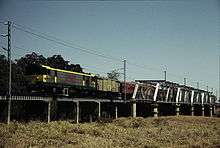
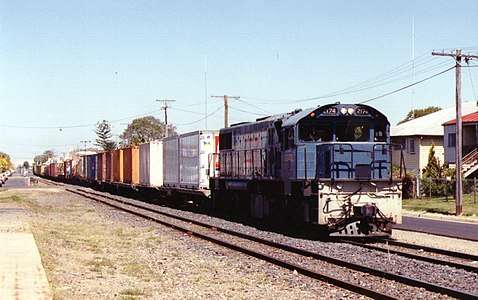
Passenger services are provided by:
- Long distance trains from:
- Brisbane to Cairns
- Townsville to Mount Isa
- Brisbane to Rockhampton and Longreach
- Brisbane to Charleville
- Brisbane to Sydney by the standard gauge XPT
- the Brisbane-centric TransLink network providing services:
- south to Beenleigh and Varsity Lakes on the Gold Coast
- north to Ferny Grove, Shorncliffe, Kippa Ring, Caboolture & Gympie;
- east to the Brisbane Airport and Doomben on the north side of the Brisbane River and to Cleveland on the south side of the river; and
- west to Ipswich, Springfield and Rosewood.
The TransLink network consists of approximately 300 route km and 151 stations.[1]
History
Construction
Construction of the Queensland rail network began in 1864 with the first section of the Main Line railway from Ipswich to Grandchester being built. This was the first narrow gauge main line constructed in the world [2] and is now the second largest narrow gauge railway network in the world.[3]
Network extent
At its maximum extent in 1932, the system totalled ~10,500 km of routes open for traffic.
In 1925 QR employed ~18,000 people, 713 locomotives, 930 passenger carriages, ~16,000 goods wagons, hauled ~five million tons of goods and ~30 million passengers, and made a return on capital of 3.2% before depreciation.
Electrification
Three significant electrification programs have been undertaken in Queensland which include the Brisbane suburban network, the Blackwater and Goonyella coal networks, and the Caboolture to Gladstone section of the North Coast line.
Public float
On 2 June 2009 the Queensland Government announced the 'Renewing Queensland Plan', with Queensland Rail's commercial activities to be separated from the Government's core passenger service responsibilities. The commercial activities were formed into a new company called QR National Limited.[4][5] The new structure was announced by the Queensland Government on 2 December 2009,[6] and took place from 1 July 2010.[7]
Infrastructure
Track gauge
The nascent Queensland Railways was persuaded that the way to reduce the cost of railway construction was to use a narrower gauge than the standard gauge of 4 ft 8 1⁄2 in (1,435 mm). A prototype existed in Norway, but Queensland became the first rail operator in the world to adopt narrow gauge for a main line. The proposed 3 ft 6 in (1,067 mm) gauge railway involved a 5 long tons (5.1 t; 5.6 short tons) axle load and very sharp curves of 5 chains (100.58 metres) radius on the long climb to Toowoomba at about 610 metres (2,000 ft) above sea level. The maximum gradient was 1 in 50 (2%) uncompensated, which combined with a 5 chains (100.58 metres) radius curve gives an equivalent grade of 1 in 41 (~2.5%). Although the proposed railway could only manage a top speed of 20 mph (32 km/h), that was claimed to be sufficient for a hundred years.[8]
One of main advantages of a narrow gauge railway is that the earthworks required during construction do not have to be as extensive.[9] It was estimated that the cost of this standard of railway would be 25% of the cost of a standard gauge line built to the minimum standard considered possible with that gauge at the time. As the colony of Queensland had a non-indigenous population of ~30,000 at the time the decision was made, it is understandable. Standard gauge branch lines were later constructed in NSW with 5 chains (100.58 metres) radius curves and had the same low maximum speed.
The choice of the non-standard 3 ft 6 in (1,067 mm) gauge was and still is controversial, and the choice was approved very narrowly by parliament.[10] Thus the die was cast for a large narrow-gauge system, which was copied by three other Australian states as well as a number of other countries. A hundred and fifty years later, Queensland is still sparsely populated (5 million in 2018), but many trains hauling coal are some of the longest and heaviest in the world, with Aurizon currently trialing coal trains of 25,000 tonne gross load that are ~4.5 km long.
Rack railway
QR had one rack railway, with grades as steep as 1 in 16.5 (6%), which was on the branch to Mount Morgan. It was bypassed by a conventional line in 1951 with grades of 1 in 50 (2%). The bypass closed in 1987. The rack system was the Abt rack system, the same type used by the Mount Lyell Railway in Tasmania.
Operators
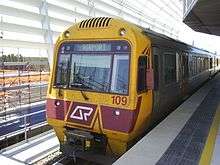
Historically the government owned Queensland Rail has been the main rail operator in Queensland. The exception has been the standard gauge link from New South Wales into Brisbane. When opened in 1930 it was operationally a part of the New South Wales system and run by that government owned railway, under agreement with Queensland which owned the line. From 1994 National Rail took over the operation of virtually all standard gauge freight services to and from Brisbane, as part of a reorganisation of interstate freight in Australia.[11]
In 2002 QR entered the standard gauge market through subsidiary Interail, by 2004 it was running freight services from Brisbane through to Melbourne.[11] Today standard gauge freight services are operated by Pacific National after its acquisition of National Rail, and Aurizon (formerly a Queensland Rail subsidiary, QR National).[11]
On the narrow gauge Queensland Rail operates all passenger services. In 2005 the first non-QR narrow gauge commercial rail operation started in Queensland, with Pacific National commencing operation of container services between Brisbane and Cairns,[12][13] followed in 2009 by their entry into the export coal market.[14] Queensland Rail's subsidiary Australian Railroad Group have also entered the Queensland narrow gauge freight market, operating trains between Townsville and Mount Isa in its own right.[15] Standard gauge passenger services are provided by the New South Wales Government's NSW TrainLink using its XPT.
Airtrain
The Airport railway line opened to passengers in May 2001.[16] Under a BOOT scheme – build, own, operate and transfer – the Queensland Government licensed Airtrain Citylink to build the rail line, to own and operate it, and hand the entire infrastructure over to the Queensland Government after 35 years when the company will then cease to exist.[17][18] Airtrain Citylink contracted Transfield Services to build, operate and maintain the line[17] and finally Airtrain Citylink contracted Queensland Rail to provide rolling stock for the rail line.[19]
Aurizon
In 2010 the Queensland government privatised the narrow gauge freight haulage and all standard gauge components of Queensland National. In 2012 the organisation renamed itself Aurizon.
Pacific National
In March 2005 Pacific National Queensland became the first non-Queensland Rail narrow gauge commercial rail operation in Queensland, with the commencement of container services between Brisbane and Cairns. They now operate intermodal services to various destinations along the coast of Queensland. In 2018 they became responsible for sugar haulage in Central and North Queensland.
Watco Australia
In 2019 Watco
BHP Mitsubishi Alliance
BHP Mitsubishi Alliance (BMA) is a 50/50 partnership between the two named companies, operating 9 coal mines in the Bowen Basin. BMA Rail was authorised to operate on the Goonyella coal network from 1 January 2014, and purchased a number of Siemens E40 AG-V1 electric locomotives. It has the potential to operate its own trains if contract haulage rates from either Aurizon or Pacific National are unacceptable.[20]
Tramways
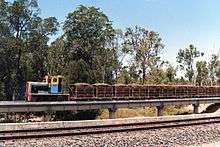
Except where noted, this section relates to sugar cane lines in Queensland built to narrower than 3 ft 6 in (1,067 mm) gauge, and in this section the term ‘narrow gauge’ means a gauge less than 3 ft 6 in (1,067 mm). Non sugar cane tramways covered by their own entries are:
- Aramac Tramway
- Ballara Tramway
- Beaudesert Shire Tramway
- Belmont Tramway
- Buderim Tramway
- Cooloola Tramway
- Innisfail Tramway
- Laheys Tramway
- Mapleton Tramway
- Mill Point Settlement Site
- Stannary Hills Tramways
Sugar cane tramways were usually developed in conjunction with sugar mills as the major transport system for conveying harvested sugar cane for processing. As this is a seasonal traffic, minimising cost was a significant consideration, and the adoption of 2 ft (610 mm) gauge enabled lines to be laid with minimal earthworks, sharp curves, and sometimes temporarily in cane fields so cut cane can be loaded directly onto wagons.
History
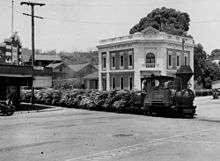
The first recorded use of a locomotive hauled tramway for sugar cane transport in Queensland was at a plantation at Morayfield (now an outer suburb of Brisbane) in 1866 using 3 ft (914 mm) gauge. The plantation was not a success, however another tramway built at Maryborough in the same year was successful.
A 3 ft 6 in (1,067 mm) gauge tramway was established at the Pioneer Mill near Ayr in 1875, and in 1881 a 50-mile (80 km) tramway network had been established to service CSR Homebush and Victoria mills. The Herbert mill had an 8-mile (13 km) network by 1882, and further tram networks were established as the sugar industry expanded, all 2 ft (610 mm) gauge with the exception of the Pioneer Mill system.
At the end of World War I surplus equipment that had been used to rail supplies to the trenches was used to expand the sugar cane networks.
Originally cane was harvested by hand, and the ‘standard’ 4 wheel wagon was loaded by stacking the ~2 m lengths of cane between upright stakes.
In the 1950s mechanical harvesting was introduced, and cane ‘bins’ were required to hold the ~200 mm lengths (‘billets’) of cane produced by that harvesting process. Most cane bins are 4 wheel with a 4-6 tonne capacity, but some mills utilise bogie bins with a capacity of ~10 tonnes.
Diesel mechanical and diesel hydraulic locomotives replaced steam locomotives in the 1950s and 1960s. Cane must be processed within 12 hours of harvest for maximum yield, so the transportation timing dictated the size of a cane tramway network when mills were first established. When diesel locomotives were introduced, their increased utilisation rates enabled the size of a potential network to grow, resulting in the rationalisation of both the tramways and a reduction in the number of mills. Today some of the ‘main lines’ of tramways are of a standard equivalent to a 3 ft 6 in (1,067 mm) gauge main line, with (in some cases) concrete sleepers, ballast and heavy rail allowing relatively high speed transport of the cane from further distances whilst still meeting the 12-hour ‘delivery from harvest’ timeframe.
Queensland Railways sold a closed branchline in 1964 to the Gin Gin Cooperative Mill[21] in Gin Gin which converted it to a 2 ft (610 mm) sugar tramway.[22]
With the development of higher standard road networks, some mills have converted to road transport for some or (in a few cases) all cane delivery.
Nambour, about 100 km north of Brisbane had a sugar tram network until 2003, when the mill closed due to plantations being sold for urban development reducing the district crop harvest to an unviable size. The Rocky Point Mill situated about 50 km south of Brisbane had a 5-mile (8 km) tramway which opened in 1924 and closed following flood damage in 1951. Road transport has been used for that mill since then.
Current situation
In 2014 there were 19 sugar cane systems (18 of which use 2 ft or 610 mm gauge) with a combined trackage of 3,000 kilometres (1,900 mi) hauling approximately 36M tonnes of sugar cane each season. The average distance cane is hauled is 35 km, with the longest line being 119 km. Average speed is 40 km/h (due to the wagons not having brakes), and the maximum load is 2000 tonnes, being 1 km long.
It is understood the Pioneer Mill is considering converting its network to 610 mm (2 ft) gauge to enable it to more easily procure rolling stock and to facilitate greater efficiency of operations with two neighbouring mills, which currently share 25 km of dual gauge track.
Contemporary sugar cane tramways are quite advanced technically, utilising relatively heavy rails cascaded second hand from other operators, remote-controlled brake vans, concrete sleepers (in places), ballast and tamping machines. The 19 separate tramways cooperate in research and development.
Rolling stock
Passenger
TransLink
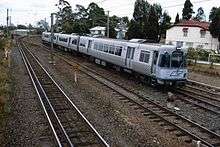
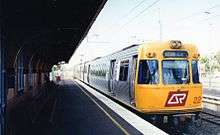
For TransLink services as far as Gympie North, Queensland Rail's rolling stock is electric and air-conditioned.
- Electric Multiple Units (EMU) – 88 three car units introduced from 1979, now being phased out as a result of the introduction of 700 series[23]
- Suburban Multiple Units (SMU)
- Interurban Multiple Units (IMU)
- InterCity Express (ICE) – 8 two car units plus 4 trailers (20 cars in total) introduced in 1988.
All trains are electric multiple units with a driver cabin at both ends, with the exception of EMU60 through to EMU79 (now all withdrawn) which had a driver's cab at one end, and guard only cab at the other end. These units also had only 3 powered bogies (per 3 car set) compared to the 4 powered bogie arrangement for the remaining EMUs. The 1X0 and 2X0 series units consist of three cars each, while the 700 series are 6 car units.
The 700 series, built in India, suffered from a design fault for disability access. Due to the rejection of an exemption application to the Australian Human Rights Commission, rectification work was required involving the fitting of a second toilet that met the Disability Discrimination Act 1992 requirements.[30]
Long-distance services
Long-distance services are operated by Traveltrain, a division of Queensland Rail. Traveltrain services mainly cater to a tourist market.
- Tilt Trains
- The Electric Tilt Train operating from Brisbane to Rockhampton
- The Spirit of Queensland, a Diesel Tilt Train operating from Brisbane to Cairns which replaced The Sunlander, a locomotive hauled train that was withdrawn in 2014.
- Locomotive hauled trains
- The Spirit of the Outback operating from Brisbane to Longreach. When introduced in 1993, it combined two previous trains, the Capricornian and The Midlander.
- The Inlander operating from Townsville to Mount Isa
- The Westlander operating from Brisbane to Charleville
- Tourist Trains
- The Gulflander, a rail motor operating on the Normanton to Croydon line
- The Kuranda Scenic Railway operating from Cairns to Kuranda
- The Savannahlander, a rail motor operating from Cairns to Forsayth
History
Queensland's first premier passenger service was the Sydney Mail, introduced in 1888 when the New South Wales line opened to Wallangarra. From 1923 it included a Parlour Car, which was transferred to the Townsville Mail in 1930 following the opening of the 1,435 mm (4 ft 8 1⁄2 in) standard gauge line to Brisbane from Sydney.
In 1935 the Sunshine Express was introduced on the Brisbane – Cairns service, being the first completely roller-bearing equipped train in Australia.
The Inlander was the first train in Australia with air-conditioned sleeping cars.
Rail Ambulances
Rail Ambulances, possibly unique to Queensland, operated from 1918-1990. More detail is provided in this article.
Locomotives
Steam
A list of QR steam locomotives is contained here
Diesel
A list of QR diesel locomotives is contained here
Electric
A list of electric locomotives operating in Queensland is contained here
References
- "Our Services" Archived 7 January 2014 at the Wayback Machine, Queensland Rail
- Kerr, J. 'Triumph of Narrow Gauge', Boolarong Publications 1990
- "Queensland's steam Railways". Transport Trust. Archived from the original on 29 October 2013. Retrieved 27 October 2013.
- Calligeros, Marissa (2 June 2009). "Queensland asset sales to reap $15 billion". Brisbane Times. Archived from the original on 19 October 2009.
- "Queensland assets sale". Queensland Government. Archived from the original on 14 April 2010. Retrieved 20 July 2010.
- "Govt outlines rail freight sale". Sydney Morning Herald. 8 December 2009. Archived from the original on 5 March 2018. Retrieved 5 March 2018.
- Korporaal, Glenda (15 April 2010). "Hockridge carrying the burden of Queensland Rail". The Australian.
- "PARLIAMENT". The Courier. Brisbane: National Library of Australia. 27 August 1863. p. 2. Retrieved 11 January 2013.
- "Railways in Australia and great train journeys". culture.gov.au. Australian Government. Archived from the original on 20 September 2010. Retrieved 17 September 2010.
- Kerr, J. 'Triumph of Narrow Gauge' Boolarong Publications 1990
- Alan Shaw (November 2007). "All Change on the North Coast" (PDF). Railway Digest. pp. Pages 20–29. Archived (PDF) from the original on 6 July 2011. Retrieved 22 June 2010.
- "Pacific National Queensland". Archived from the original on 23 March 2010. Retrieved 22 June 2010.
- Jenny Woodward (11 March 2005). "Making Tracks". Stateline Queensland. www.abc.net.au. Archived from the original on 11 November 2012. Retrieved 22 June 2010.
- Jennifer Perry (20 May 2009). "PN commences Qld coal haulage operations". Rail Express. Archived from the original on 1 October 2009. Retrieved 22 June 2010.
- "QLD – Where We Work – Australian Railroad Group Internet". Archived from the original on 29 June 2009. Retrieved 22 June 2010.
- Debritz, Brett (6 May 2001). "Airtrain off to a flying start". The Sunday Mail. p. 50.
- "Transfield – Current Activities – Brisbane Airtrain". Archived from the original on 3 November 2009. Retrieved 25 March 2010.
- "Brisbane Airport rail link to go ahead". Archived from the original on 10 June 2011. Retrieved 25 March 2010.
- "Extra Rollingstock for Airtrain Services". Archived from the original on 10 June 2011. Retrieved 25 March 2010.
- "BMA plans to use its own trains to move coal - Australian Mining". 6 November 2012. Archived from the original on 5 March 2018. Retrieved 5 March 2018.
- "Gin Gin". Archived from the original on 9 March 2015.
- Milne, Rod (June 1997). The Wallaville Branch Line. Australian Railway Historical Society Bulletin. pp. 179–187.
- "Citytrain fleet – Electric Multiple Unit". Archived from the original on 30 September 2009. Retrieved 25 March 2010.
- "Citytrain fleet – Suburban Multiple Unit 200 Series". Archived from the original on 30 September 2009. Retrieved 25 March 2010.
- "Citytrain fleet – Suburban Multiple Unit 220 Series". Archived from the original on 30 September 2009. Retrieved 25 March 2010.
- "Citytrain fleet – Suburban Multiple Unit 260 Series". Archived from the original on 8 June 2009. Retrieved 25 March 2010.
- "Citytrain fleet – Interurban Multiple Unit 100 Series". Archived from the original on 8 June 2009. Retrieved 25 March 2010.
- "Citytrain fleet – Interurban Multiple Unit 120 Series". Archived from the original on 17 September 2009. Retrieved 25 March 2010.
- "Citytrain fleet – Interurban Multiple Units 160 Series". Archived from the original on 8 June 2009. Retrieved 25 March 2010.
- "Human rights exemption for new trains rejected, leaving door open for legal action - Brisbane Times, March 29 2018". Archived from the original on 9 April 2018. Retrieved 8 April 2018.
External links
| Wikimedia Commons has media related to Rail transport in Queensland. |
